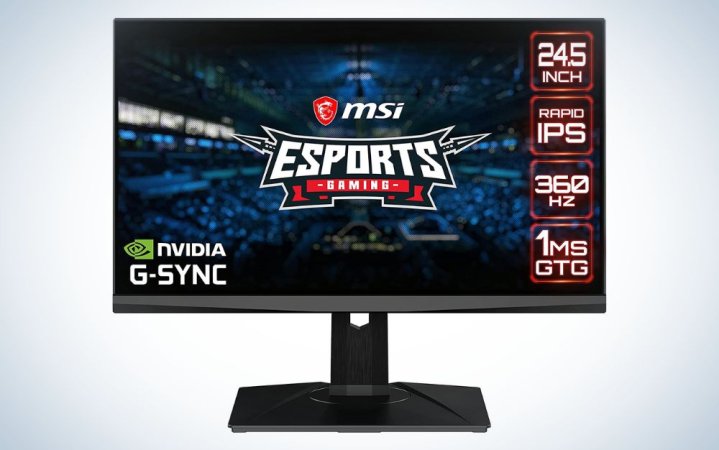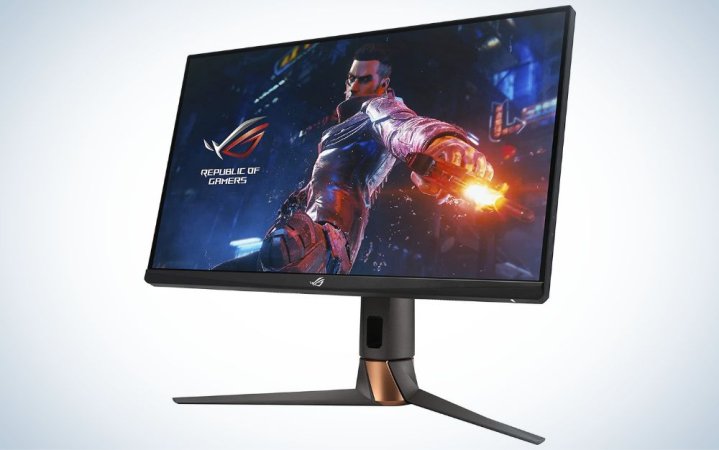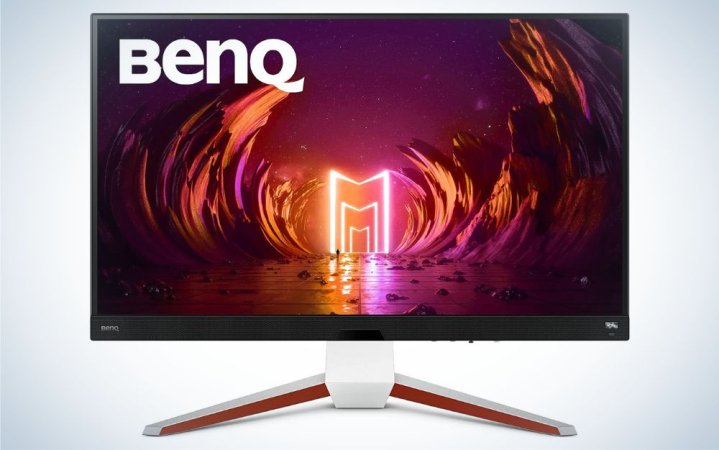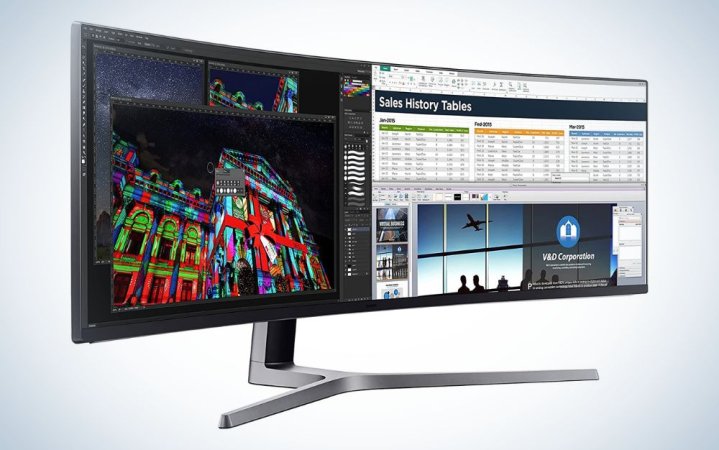We may earn revenue from the products available on this page and participate in affiliate programs. Learn more ›

Computer-aided design or computer-aided drafting software, commonly known as CAD, is used by architects, game designers, engineers, and industrial designers to produce detailed 3D models that can serve as design documents for everything from cars to buildings to zombie dragons. There are many CAD programs out there, they have enough in common that anyone using them would benefit from using the right kind of monitor—one that’s capable of showing your design with as much detail as possible. There are a lot of monitor options that make sense for CAD users, including high- and low-budget displays, curved screens, and ultrawide. We’ve selected the best monitors for CAD for everyone, including all kinds of specific needs.
- Best overall: BenQ Mobiuz EX3210U
- Best small: MSI Oculux NXG253R
- Best vertical: ASUS ROG Swift PG279QM
- Best premium: Samsung Odyssey Neo G9
- Best curved: LG UltraGear 34GL750-B
- Best budget: ViewSonic VX3276-4K-MHD
How we selected the best monitors for CAD
As a freelance journalist for over 10 years, I’ve reviewed home and tech products for many publications including Popular Science, CNN Underscored, NBC News Select, Popular Mechanics, Architectural Digest, Tom’s Guide, The Daily Beast, USA Today’s Reviewed, Apartment Therapy, The Spruce, and Bob Vila. Our CAD monitor selections are based on personal testing, extensive research, recommendations from experts and fellow critics, and user impressions.
The best monitors for CAD: Reviews & Recommendations
Based on our testing and advice from our experts, we’ve selected the best monitors for CAD for many different use-cases. While most of our options follow our experts’ guidelines, we also made sure to include a couple of recommendations for users on a budget, or who may not have room for a giant display.
Best overall: BenQ Mobiuz EX3210U
Best overall
A Perfect Picture
Pros
- 4K resolution
- Automatic image optimization
- Built-in speakers and noise-canceling microphone
- Generous swivel and tilt options
Cons
- Expensive
Buy it used or refurbished: eBay
Why it made the cut: Super sharp and fast, with an ergonomic design, and brightness intelligence, and other luxury features, the BenQ Mobiuz EX3210U has everything a CAD designer needs.
Specs
- Screen size: 32-inch
- Resolution: 3840 x 2160 pixels (4K)
- Refresh rate: 144Hz
- Response time: 1ms
The BenQ Mobiuz EX3210U is the perfect picture of what you should look for in a CAD monitor. The 32-inch IPS panel runs software in sharp, bright 4K UHD at a smooth 144Hz with a snappy 1ms response time for minimal input lag.
In addition, the monitor uses brightness intelligence technology to automatically detect both screen content and environment lighting and then adjust the screen’s brightness and color temperature. This eye care feature helps to reduce eye strain and headaches. Plus, the monitor has an ergonomic design that can tilt from -5 to 15 degrees and swivel from -15 to 15 degrees.
It also offers plenty of non-essential quality-of-life features, including internal speakers and a noise-canceling microphone, giving you an easy built-in audio solution. It also features FreeSync Premium Pro variable refresh rate support.
Best small: MSI Oculux NXG253R
Best small
Speed Demon

Pros
- 360Hz refresh rate
- Vertical mode
- Tilt and swivels
- Vibrant colors
Buy it used or refurbished: eBay
Why it made the cut: As smaller monitors go, this one punches above its weight with a 360Hz refresh rate.
Specs
- Screen size: 25-inch
- Resolution: 1920 x 1080 pixels
- Refresh rate: 360Hz
- Response time: 1ms
Con
- Excessive branding on back
As a rule, we recommend large monitors for CAD use. However, if you have limited space and you’re working on a limited budget, the 25-inch MSI Oculux NXG253R delivers rich, vibrant colors and has many of the other features you’d want and need. This 25-inch rapid IPS panel offers a ridiculously quick 360Hz refresh rate—the fastest you can get right now—along with 1ms response time and Nvidia G-Sync support. It’s made for esports but would work well as a monitor for designers if a larger screen isn’t an option.
Best vertical: ASUS ROG Swift PG279QM
Best vertical
Tight spaces

Pros
- 240Hz refresh rate
- Ultra-low blue light technology
- Can be viewed in vertical mode
- Swivels
- Height adjustable
Cons
- Not 4K
- Costs a pretty penny
Buy it used or refurbished: Amazon
Why it made the cut: The lightning-fast refresh rate and other features make this stylish monitor ideal for CAD use.
Specs
- Screen size: 27-inch
- Resolution: 2560 x 1440 pixels (QHD)
- Refresh rate: 240 Hz
- Response time: 1ms
The ASUS ROG Swift PG279QM is sharp and sharp-looking. The stylish 27-inch, 1440p display isn’t the largest or most pixel-dense option, but it offers incredible color accuracy—97 percent DCI-P3 wide color gamut and 150 percent sRGB color space coverage—offering bright, vibrant colors and precision in your designs. With an esports-grade 240Hz refresh rate, games and models will animate smoothly. The monitor is also designed to be easy on the eyes. It uses flicker-free technology and has four different filter settings to control blue light reduction levels.
It’s also one of the very few monitors with a fully adjustable stand—allowing you to tilt, swivel, pivot, and adjust its height to get the perfect viewing position. It also rotates vertically, making it great for reviewing code or simply allowing you to save even more space in a pinch.
Best premium: Samsung Odyssey Neo G9
Best premium
Wide Enough For All Your Windows

Pros
- Extremely large, 32:9 ultrawide screen
- QLED panel
- Mini-LED backlighting allows for local dimming
- Curved
Cons
- Expensive
Buy it used or refurbished: eBay
Why it made the cut: Bigger is definitely better with Samsung’s curved ultrawide Odyssey Neo G9, which can take the place of two monitors.
Specs
- Screen size: 49-inch
- Resolution: 5120 x 1440 (32:9)
- Refresh rate: 240Hz
- Response time: 1ms
If you prefer the idea of using one super ultrawide monitor over two separate monitors, Samsung’s largest ultrawide gaming monitor, the Odyssey Neo G9 pulls out all the stops. The curved, 49-inch panel provides almost double the screen real estate of a 27-inch display. With a QLED panel and 2,048 local dimming zones, it offers one of the brightest displays you’ll find—2,000 NITs of bold projection. It’s also highly accurate, showing 125 percent sRGB and 95 percent DCI color coverage. It’s fast, too, topping out at 240Hz and a 1ms response time. The Samsung Odyssey Neo G9 is bigger than big, and has a price tag to match: It’s a spectacular display, though, if you’re willing to pay for the privilege.
Best curved: LG UltraGear 34GL750-B
Best curved
Curved and Ultrawide For The Rest of Us
Pros
- Ergonomic stand with height adjustment, tilt, and swivel
- Can be used in vertical mode
- Great price
Cons
- No speakers
Buy it used or refurbished: eBay
Why it made the cut: A 34-inch curved monitor with a high resolution, fast refresh rate, and quick response time that doesn’t cost an arm and a leg.
Specs
- Screen size: 34-inch
- Resolution: 2560 x 1080 (21:9)
- Refresh rate: 144Hz
- Response time: 1ms
The LG 34GL750-B is another great curved ultrawide monitor that, at 34 inches, might feel a little more reasonable for folks who balk at the idea of clearing off their desks for a 49-inch display. The 21:9 curved IPS display still gives you plenty of real estate and the curvature provides an immersive experience that helps you focus on what you’re doing and avoid distractions. With a 144Hz refresh rate, G-Sync compatibility, and a 1ms response time, your models should animate smoothly.
Best budget: ViewSonic VX3276-4K-MHD
Best budget
The Cheapest 32-Inch 4K We Could Find

Pros
- Inexpensive
- Ultra-thin
- Adjustable stand
- Built-in speakers
Cons
- 60Hz refresh rate
- Stand isn’t adjustable
Buy used and refurbished: Amazon, eBay
Why it made the cut: It may not be the most impressive, but the ViewSonic VX3276-4K-MHD is one of the most affordable 4K displays out there.
Specs
- Screen size: 32-inch
- Resolution: 3840 x 2160 pixels (4K)
- Refresh rate: 60Hz
- Response time: 3ms
The ViewSonic VX3276-4K-MHD offers the biggest bargain you’re likely to find on a 32-inch, 4K monitor. It tops off at a 60Hz refresh rate, the bare minimum these days, and has a less-than-stellar response time. Despite all that, it’s a good buy. The monitor uses flicker-free and blue light technology to help reduce eye strain and is VESA compatible. It can tilt forward 4 degrees and tilt backward 15 degrees.
What to consider when picking one of the best monitors for CAD
It turns out that the best CAD monitors are often gaming monitors. According to Martin Murphy—endowed department head of virtual reality development at Ringling College of Art and Design in Sarasota, Fla.—many developers who use CAD to make virtual models also use game engines.
“For many clients, it is becoming more common to pre-visualize the end product or space in a game engine in order to solicit early feedback or to secure a contract,” Murphy says. “You can import CAD and BIM (building information modeling) data to create stunningly realistic 3D renders of an environment that you can interact with in real-time.”
While you can take Murphy’s advice and simply pick the best gaming monitor you can afford, we found there were some more specific criteria if you want to specifically optimize for CAD use.
Size
For 3D modeling work, you should prioritize getting the largest monitor possible.
“Using the largest possible monitor when designing is important when detailing complex structures,” says Peter Jalbert, scale modeling expert in Floating Offshore Wind at the University of Maine’s Advanced Structures and Composites Center. “The more real estate you have to work with, the better for seeing as much of the subject as possible when designing the interface of multiple components of the overall structure.”
Robert Hurlston, EngD—principal and chief engineer at Fidelis Engineering Associates in New Boston, Mich., which provides custom CAE solutions—concurs, noting that ultrawide monitors may be particularly useful. “I think the size—or rather width—of the display is really important and often the very wide monitors can be useful when reading or generating engineering drawings.”
Hurlston and Jalbert also agreed that a dual- or even triple-monitor setup (with an appropriate desk and stand) can also help, since it would allow CAD users to look at both their model and their reference materials. “Whenever possible,” Jalbert says, “supporting dual monitors is useful to have reference material on one screen and the CAD program on another to drastically increase productivity. … I have two external, 4K monitors for my day-to-day design work to provide that real estate and support efficiency.”
Resolution and frame rate
We always recommend keeping resolution and frame rate in mind when picking in a monitor. Resolution indicates how many pixels your monitor uses to generate an image. Frame rate, measured in Hertz (Hz), tells you how many times your monitor can update what’s happening on screen, allowing for smoother animation.
Like other forms of creative production, having a higher resolution pays off when using CAD software.
“There’s a need for really good resolution for accurate manipulation of parts and assemblies,” Hurlston says, “and precise color rendition, particularly when utilizing high-end CAD tools that allow photorealistic rendering.”
We generally recommend scaling up resolution when you buy larger monitors. Since you want to go as large as possible, it also makes sense to get a 4K display if possible. We’ll take it a step further than usual, and add that it may make sense to go for a 27-inch 4K display so you see the sharpest, most detailed version of your model.
Likewise, frame rate is also essential. “When you’re moving and spinning things around, you don’t want any lag between input and visualization,” Hurlston says. We normally recommend most users go for 144Hz or higher when purchasing a gaming monitor, including when you’re using one for CAD.
Panel type
The type of screen panel used in your monitor can also impact its color accuracy. There are three core types of LCD display: In-plane switching (IPS), vertical alignment (VA), and twisted nematic (TN). Each panel type has its own benefits and drawbacks, but Murphy suggests that IPS panels, which are often preferred for color precision, are the best fit for designers.
Budget
The monitor that our experts described for using CAD—a 32-inch, 4K gaming monitor with great color accuracy—is truly top-of-the-line, which means you should expect it to cost a lot. If you’re buying this monitor for personal use, we can’t recommend breaking the bank purely to optimize for some niche software. If you have a tight budget, get the best CAD monitor that you can afford. It may not be 4K and may not be ultrawide, but you can always upgrade later.
FAQs
Our experts recommend using multiple monitors or an ultrawide display that provides extra room for multiple windows for CAD projects. The number of displays that work best for you comes down to personal preference and budget, but using two or three displays is definitely not a bad idea.
Gaming monitors tend to have specs and features that also make them a good fit for CAD software. For example, Martin Murphy notes that variable refresh rate support helps virtual models look sharp:
“If you get a monitor with G-Sync Ultimate certification, this will eliminate any chance of screen tearing, stuttering, or lag,” he says. “Screen tearing is a graphical artifact that is most notable in imagery with high contrast, such as a building in partial shadow against a clear blue sky.”
That depends on what you’re using it for. If you use CAD programs on a regular basis at work, then it probably pays to give yourself the best possible tools to optimize your performance. According to Murphy, having best-in-class equipment may allow you to charge for “in-person critical viewing consultations.”
If you are buying this monitor for personal use, you’re the only one who can decide whether a high-end monitor is worth the expense.
Final thoughts on the best monitors for CAD
If you use CAD software, your monitor can make or break your designs. The right CAD monitor provides plenty of screen real estate, sharp resolution, high maximum refresh rate, and a low response time. All of these components are important to create professional designs with true-to-life colors, and smooth images that resist stuttering and tearing. Since CAD experts recommend using gaming monitors, there’s a wide range of options to choose from, though, with options to meet any budget.





